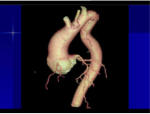


Disclaimer Privacy Policy
Copyright (c) 2021 Bicuspid Aortic Foundation, All Rights Reserved


Creating a Climate of Hope, an Atmosphere of Caring, and Information for All

TAD
Is simply aortic
disease in the chest
The aorta above shows several signs of disease. A bulging root, bulging ascending aorta, and elongated, curving (tortuous) descending aorta.
Thoracic Aortic Disease (TAD) - the OTHER KILLER in the Chest
Sometimes, TAD is the Only Name We Have
If you were to visit a medical center and meet some of the patients there, you would find several of them with various forms of Thoracic Aortic Disease (TAD). Sometimes, there is something else that describes them, such as those with BAV, or perhaps an underlying cause, such as chronic hypertension. There are those with defined syndromes. But sometimes, the only name known for them is the general one, TAD. Thoracic aortic disease includes dilatation and aneurysm (bulging), coarctation (narrowed), dissection (tearing), intramural hematoma (IMH), and rupture of the aorta in the chest. In BAV families, some have a bicuspid aortic valve, while others do not. However, today we are learning from these families that there is something else beyond just the valve leaflets that needs to be considered. As one woman said, “My brother has BAV and aneurysm, my son has BAV and aneurysm, but I have an aortic valve with all three leaflets and an aneurysm. I am not BAV, so what am I called?” To be inclusive, we use the terms BAV/TAD and TABAV to describe these families. In other families, there may be no indication of BAV at all, and yet they have thoracic aortic disease as described above. Familial TAD is the only name we have. Sometimes, the reason for thoracic aortic disease could be infection, chronic hypertension, or smoking.Regardless of the Underlying Cause, TAD is the
OTHER KILLER in the Chest
Heart disease has historically been known as the number one killer of both men and women. However, there is another less well-known disease in the chest, thoracic aortic disease. Sudden death that seems "heart related" may sometimes actually have been caused by thoracic aortic disease.

- Aorta
- BAV and Other Heart Valves
- Blood Pressure
- Exercise/Weight Lifting
- Featured Papers
- Guidelines
- Familial TAAD
- History
- Honoring Dr. M.E. Abbott
- Pictures (graphic content)
- Pictures Valvular Strand, Aneurysm (graphic)
- Prosthetic Heart Valves
- Scientific Awards
- Spotlight on Research - Coming Soon
- Video (graphic content)
































